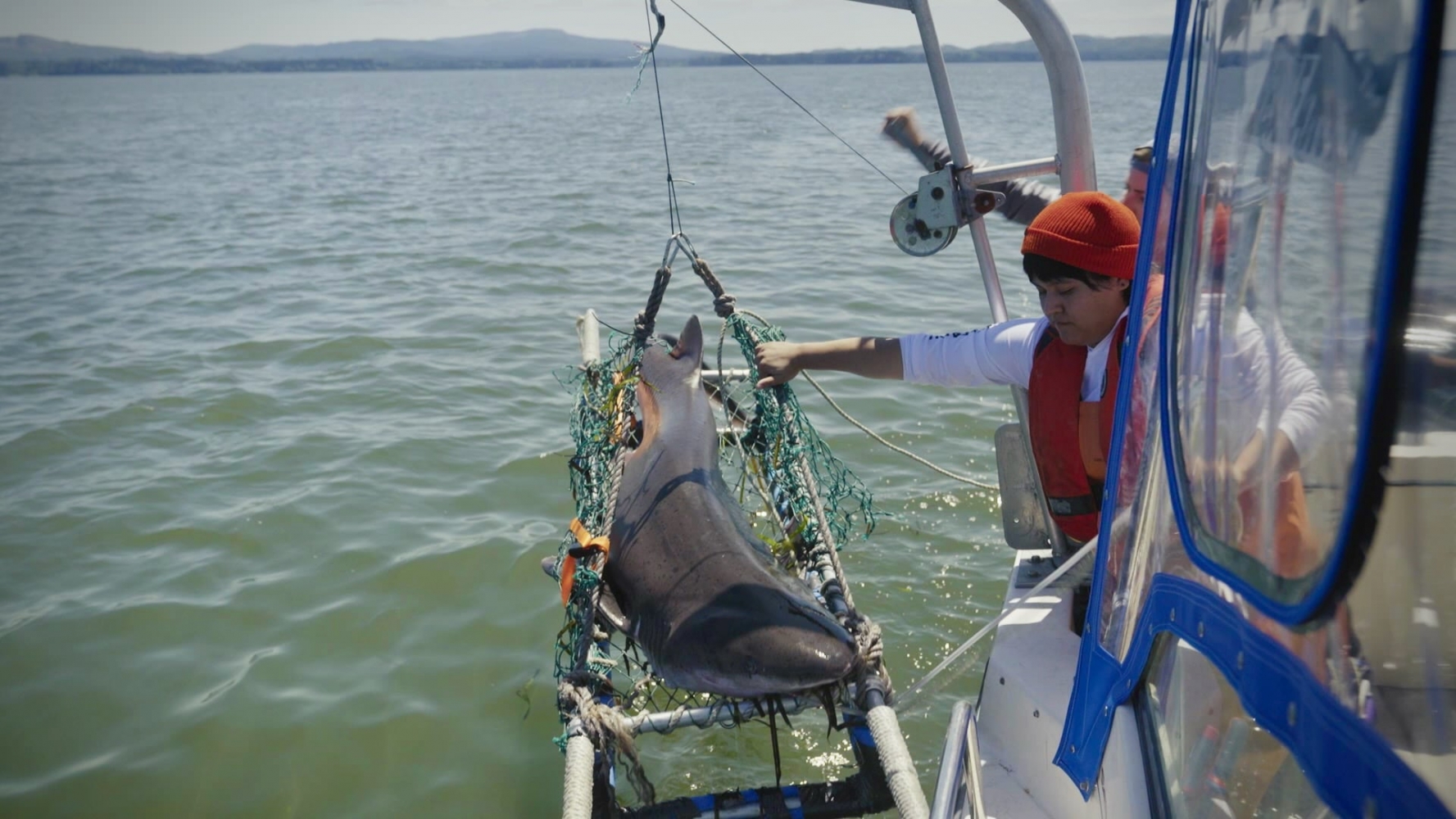

Published on: 11/20/2025
This news was posted by Oregon Today News
Description
Catching one of the Pacific Northwest’s top predators takes time, a little luck and big chunks of meat.
Oregon State University shark researcher Jess Schulte grabs a fishing hook about as big as her palm. She calls out to undergraduate intern Deven Guerrero, who’s elbow deep in the bait bucket at the back of the boat.
“Can I trade you for a salmon tail? I think it’s good luck. They love a salmon tail,” she says.
It’s the height of summer in Washington’s Willapa Bay, and Schulte, Guerrero and Alex McInturf are studying broad-nosed sevengill sharks, one of about 15 shark species native to the Pacific Northwest.

“Understanding sevengills is understanding the entire ecosystem. They are apex predators,” explains Schulte, who’s completing her Ph.D. with OSU’s Big Fish Lab. “And so understanding them is like understanding how all the other animals in the ecosystem are existing.”
The bay in Southwest Washington is known around the world for its oysters. Lesser known is that every summer Willapa Bay turns into a shark superhighway. Sharks, especially sevengills, migrate in from the ocean in large numbers. Northwest researchers are trying to understand why.
“This was what haunts me at night. Why are there so many sharks here?” Schulte says.

Big mama on board
Sevengill sharks have largely flown under the radar in the public’s mind. Brown with dark spots along their back, they live in the nearshore and often hang out close to the bottom. They don’t have a dorsal fin like most sharks — the one you’d see poking above the surface of the water — instead, their top fin is pushed back near the tail.
“Sevengills are very, very unique. They’re one of two species in the world that have seven gill slits. And it’s thought that they have seven gill slits because they’re such an ancient species. So these are actually one of — if not the oldest shark species alive,” Schulte says.
Similar sharks have been swimming in our oceans for around 200 million years.
Sevengills have even been observed pack hunting, kind of like wolves.
Thirty minutes after the bait goes in, the Big Fish Lab scientists get a hook-up. Schulte pulls in the line, thrilled with the result.
“So we have a sevengill. Wooo!” she yells. “Oh my gosh, she’s huge.”

She’s a big mama — about 7 feet long and a girthy 250-plus pounds. The scientists guide the shark into a stretcher beside the boat and winch it on board.
While the team tags, measures and draws blood, they make sure to take good care of the shark. A wand in her mouth pushes water over her gills so she can breathe — kind of like the reverse of how a scuba diver breathes underwater. A cloth over her eyes keeps her calm.
With female sevengills like this one, the scientists have another kind of opportunity.
“One of our specialties in the Big Fish Lab is learning more about shark moms,” says Alexandra McInturf, co-director of the lab. “We are trying to advance our understanding of shark reproductive ecology — so basically what shark moms do, where they go, how often they give birth.”

Traditionally, trying to figure these things out involved killing and dissecting female sharks. But here, ultrasound is the tool of choice.
“So the ultrasound works exactly the same as it works for humans. We literally even use gel,” she says.
McInturf squeezes a line of gel onto the shark’s belly, and slowly moves the probe along the shark’s rough skin.
“There’s some circles on there,” Schulte says, monitoring the image on a small screen.
“Circles are potentially indicative of eggs,” McInturf says. “A lot of the females we capture generally in Oregon and Washington tend to have eggs or are already pregnant.”

Upon closer inspection, the scientists notice the eggs haven’t been fertilized yet, suggesting the shark may not be looking to mate in Willapa Bay.
“She’s not pregnant, but she seems to be ready to become pregnant at some point,” McInturf says.
After about 10 minutes, their work with the big female is done. They hoist the shark and stretcher over the side of the boat and lower it into the water.
“Thank you lady!” Schulte calls as the shark swims down into the murky water.
Puking the shark
Broadnose sevengill sharks come to Willapa Bay every March. The crew has tagged more than 300 sharks here over the past few summers, hoping to figure out what prompts the migration.
“I meet a lot of people who have no idea that there are sharks in these waters.” Schulte says. “It’s not a bad thing to have sharks here. In fact, it’s a really good thing. If you want to have a healthy ecosystem, you need to have sharks in the area.”
They’ve learned the sharks can cover a lot of ground in the off-season. One of their tagged sharks was caught by a fisherman in San Diego, California. Another was clocked swimming up to Alaska.
“Understanding what sharks are doing helps us understand how to keep the system together,” says Big Fish Lab co-director Taylor Chapple. “If we want to be able to fish — to catch salmon, to catch crab — we need to understand how the predators are playing in those systems.”
When it comes to the sevengills, that question of ‘why Willapa?’ still haunts Schulte.

“They’re actually much more social than we think they are. And so it’s possible that they could be coming up here for some sort of sevengill hangout, in addition to a buffet of food,” she says.
The team hasn’t nailed down details of the social lives of sevengills in the bay, but they have solved the mystery of what the sharks are eating — with a revealing technique.
“It doesn’t harm the shark, but it does take their lunch,” she says.
The technical term is “nonlethal lavage,” but in boat lingo, they call it “puking the shark.”
They bring another shark on board — this time about a 5-foot male.
“All right, you’re on head,” Schulte says to Chapple as they lower the shark’s head.
“I’m on head,” he responds, pulling the mouth open, revealing a line of saw-like teeth in the bottom jaw. He turns to McInturf. “You’re on the stomach.”
They move into position.
“Going in,” Schulte says as she puts a hose deep into the shark’s mouth. “I think there’s definitely seal. I can smell the seal.”
This strange superpower is an unexpected side effect of her job.

“A weird skill that I have that many people don’t is that I can predict what’s inside the shark based on the shark’s breath,” she says, laughing.
McInturf then gives the belly a squeeze.
“You got your chunks!” Schulte calls with glee as water and the shark’s lunch fills the bucket.
They pass the stomach contents through a strainer and Schulte’s suspicions are validated.
“I see fur!” says McInturf.
“The spotting pattern that we have on the fur, that’s pretty distinct for harbor seal. We also see a flipper,” Schulte explains, using tweezers to poke through the pungent pile of digested flesh.

Willapa is an incredibly productive bay — there’s shark food everywhere. And the buffet is almost certainly a major reason the sevengills congregate in Willapa Bay each summer.
There are strong runs of salmon, Dungeness crab galore, and huge white sturgeon that leap completely out of the water on the regular — all potential food sources for the sharks.
But surprisingly for these scientists, nearly two-thirds of what they’ve found in the stomachs of sevengills here has been seal.
Harbor seals and other marine mammals eat a wide variety of food depending on what’s available. And when salmon are coming through, the seals and other marine mammals feast on the runs.
“So [there’s] potential that the sevengills eating the harbor seal could be really good for the salmon in the sense that they’re keeping marine mammal populations down and allowing salmon populations to rebound,” Schulte says.
And this means these sharks are not only emblems of Willapa Bay’s healthy ecosystem; they’re likely contributing to healthy fisheries as well.
News Source : https://www.opb.org/article/2025/11/20/washington-willapa-bay-sharks-all-science-no-fiction/
Other Related News
11/20/2025
The 1A 8-player Oregon high school football playoffs continue this week and The OregonianO...
11/20/2025
Longstanding mismanagement at the Oregon Bureau of Labor and Industries has weakened its e...
11/20/2025
DEAR ABBY I recently bought a first-floor condo because I am an older woman with a knee di...
11/20/2025
On Thursday at 925 am a special weather statement was released by the National Weather Ser...
11/20/2025











